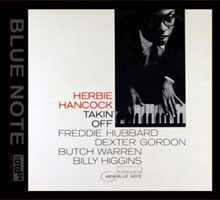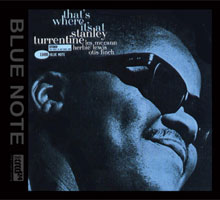Herbie Hancock • Takin' Off
Stanley Turrentine • That's Where It's At
hese are two of the last of Audio Wave's XRCD24s from the fabled Blue Note catalogue, but what a way to go out: Herbie Hancock’s Blue Note debut, and a prime Stanley Turrentine session. I asked Joe Harley, the series producer, if these would really be the last of the Blue Note XRCD24s, and he said, sadly, yes. Apparently, Blue Note is no longer licensing its back catalogue, and these last five titles were actually remastered years ago. With these, Audio Wave released 25 titles in total -- and had plans for a second group of 25. You can search the archives on The Audio Beat to find reviews of the earlier releases in the series. Takin’ Off was Herbie Hancock’s debut as both a leader and on Blue Note. It was recorded in 1962, just a year before Miles Davis asked him to join his new band. Hancock wrote five of the six selections here, and co-wrote the other one, so this is very much his work, in his blossoming style, which may explain Davis's interest. Here Hancock is joined up front by Dexter Gordon on tenor sax, and, like Hancock, relative newcomer Freddie Hubbard on trumpet. He then added Butch Warren on bass and Billy Higgins on drums. This is a distinguished lineup for a first album. The album opens with what has become Hancock’s signature tune, “Watermelon Man,” which, before it became big for Hancock, was a hit for Mongo Santamaria. While none of the remainder of the tunes here achieved quite the success of “Watermelon Man,” all are interesting and unique in the way you get to hear the maturation of Hancock. Most steer mainly into hard-bop territory, though with interesting twists and turns that reveal where Hancock’s mind was already beginning to turn. Most are up-tempo, but there is one ballad in which Hancock really shines, the last track, “Alone And I.” That’s Where It’s At was Stanley Turrentine’s sixth album for Blue Note. It features a quartet of Turrentine on tenor sax, Les McCann on keyboards, Herbie Lewis on bass and Otis Finch on drums. Outside a brief 1985 appearance with Turrentine, this is McCann’s only session work with Turrentine and Blue Note. That alone makes this a unique album. McCann sticks to the keyboard, providing no vocals -- not that you’d expect vocals from a Blue Note session of this vintage. Here the stars are both Turrentine’s huge tenor sound and the soulful way he expresses himself, and McCann’s soul-drenched piano, which fits in nicely with the fervent, expressive themes of the music, as do the contributions from the rhythm section of Lewis and Finch. The music Turrentine chooses for this album is all in his preferred and perfected style of soulful, bluesy jazz. McCann contributed four of the six tracks, with Turrentine writing one and brother Tommy Turrentine penning the final track. One the great things about this album is how neither Turrentine nor McCann tries to dominate the proceedings, but each takes his turn handling the lead, while sharing the overall musical spotlight with the bandmates. The tunes alternate between up-tempo numbers and slow, bluesy ballads. Both Turrentine and McCann are right at home with this style and that shows in the overall musicianship expressed here. Both immediately find the groove and slide right in. Sometimes it’s easy to miss where one tune ends and the next begins, so smoothly and effortlessly do Turrentine and McCann become a part of each number. The sound of these XRCD24s is outstanding. I will actually go as far as stacking it up against that of the Blue Note SACDs I've heard. Unfortunately, there are no direct comparisons in my collection, but the clarity, tonal accuracy, and sense of space are top-notch. As is usual with Rudy Van Gelder productions, the sound is a bit binary -- left or right -- but the music still shines through. Listen, for instance, to the clarity and precision of Hancock’s piano emanating from the left speaker, or Gordon’s tenor blowing out of the right. The tonal accuracy is outstanding. The big, bluesy, soulful tone of Turrentine’s tenor sax and the funkiness of McCann’s piano are clear, pure, and tonally accurate. There is one direct comparison I can make. One of the other titles in this final batch of Audio Wave XRCD24s is Lou Donaldson’s Lou Takes Off. I happen to have the long-out-of-print Classic Records 24-bit/96kHz DAD of this title. The DAD sounds richer and fuller, perhaps due to the higher resolution. But the XRCD24 countered with a more precise and accurate sound. It's a bit thinner perhaps, but clearer and more focused, with, dare I say it, a bit more tonal accuracy. It's close. Your personal tastes will dictate which you prefer, but to my ears the XRCD24 more than holds its own against the higher-resolution disc. That alone speaks volumes for just how good these XRCD24s
are. And while we are limited to the 25 titles in this series, most have not yet been
issued on higher-resolution physical discs, and that makes these XRCD24’s the
best way to listen to this glorious music. Producer Joe Harley, mastering engineer Alan
Yoshida, and executive producer Bob Bantz deserve a world of credit for using the XRCD24
process to give us these titles in superb sound and deluxe packaging. While I’ll
cherish the 25 titles in this series, a part of me will always wish for more. |


